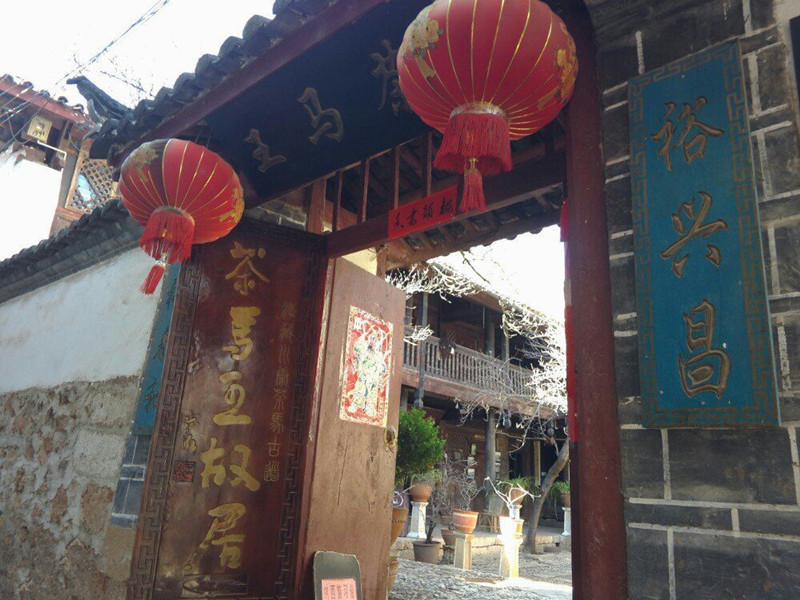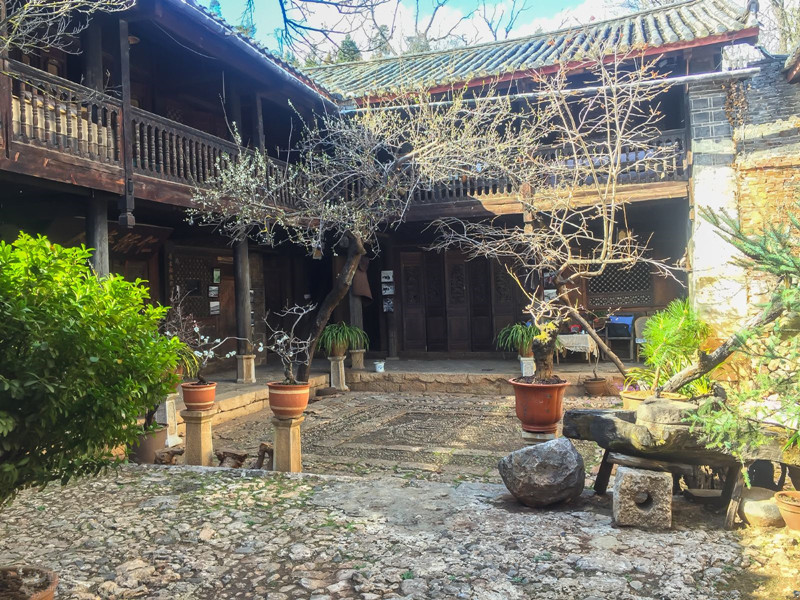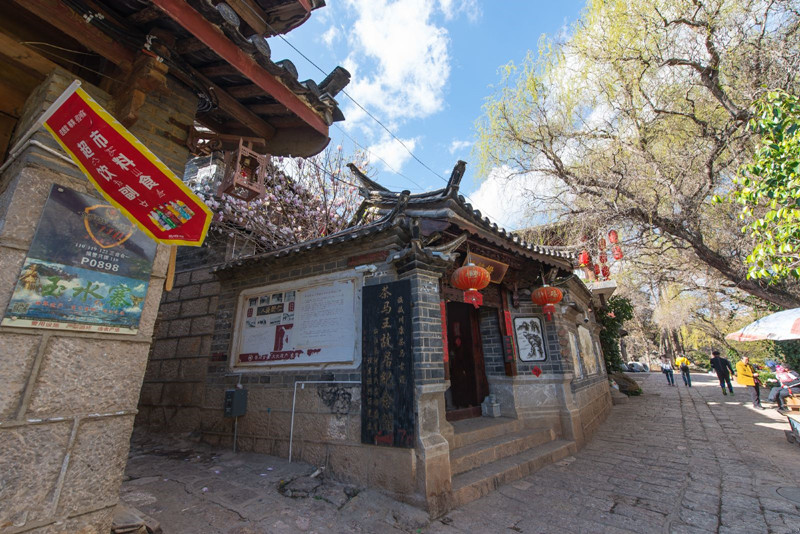Former Residence of Chamawang and Memorial Hall in Shuhe Old Town
Location and Overview
The Former Residence of Chamawang and Memorial Hall (茶马王故居纪念馆) is situated in the northwest part of Shuhe Old Town (束河古镇), adjacent to Jiuding Longtan (九鼎龙潭). To reach it, visitors should stroll along Renli Road (仁里路) to the northwest corner of the ancient town and navigate through a small alley named Tiao Shui Xiang (挑水巷). This historic residence belonged to the Wang family, who were well-known for their influential role in the horse caravan trade. The house boasts a rich history spanning over 200 years, and visitors can explore the traditional Naxi (纳西) architecture while uncovering stories from the era of horse caravans.
Architectural Features
The residence features a charming Naxi courtyard, with couplets inscribed in Dongba script (东巴文字) flanking the main entrance. The courtyard is beautifully landscaped with various flowering plants, creating a tranquil and picturesque environment.
Main House Interior
Upon entering the main building, visitors will find the meticulously preserved bedroom of the caravan leader. This room showcases an antique bed and furniture that harmoniously blends Naxi and Tibetan styles, offering a glimpse into the past. The walls are adorned with historical images and photographs of the caravan days, providing further insight into the lifestyle and challenges faced by the horse traders. A shrine is also present, dedicated to honoring the ancestors of the caravan leaders.
Reception Area and Visitor Experience
The side room on the first floor serves as a welcoming reception area for tourists, where descendants of the caravan leaders invite visitors to enjoy traditional tea and share stories about their family’s heritage. It’s essential to note that photography is not permitted inside the entire residence, and visitors are kindly requested to respect this rule.
As you make your way toward Jiuding Longtan, keep an eye out for the entrance to the residence, as it can easily be overlooked. Once inside, the hosts provide a warm welcome, eager to introduce visitors to their ancestral home and share the history of the Tea Horse Road (茶马古道). The residence is no longer inhabited by the family and is open to the public for free.
The second floor displays various tools used along the Tea Horse Road, allowing visitors to appreciate the significance of these artifacts. The ambiance of the house subtly reflects Tibetan influences, adding to its artistic charm. Downstairs, there is a tea room where visitors can savor two types of raw Pu’er tea (生普), and before departing, they can purchase traditional cakes from the hosts.
Historical Background
The Former Residence of Chamawang once belonged to one of the homes of the legendary “Tea Horse King” (茶马王). According to local lore, at the height of the Wang family’s prominence, they owned over twenty courtyards in Shuhe. However, following land reforms, these properties were divided.
The current Chamawang Memorial Hall is a two-story wooden structure that has preserved the original characteristics of the residence. Inside, visitors can find a collection of old items used by the caravans, numerous historical photographs, and intricately detailed maps of the caravan routes displayed on the walls. Through these artifacts, the memories of the caravan leaders of the past seem to come alive once more.
The Wang family has a long-standing and powerful history in the context of the Tea Horse Road, beginning their tea trade during the Ming Dynasty (明朝). At their peak, the Wang family’s caravans consisted of over 3,500 horses and more than 4,000 personnel, reaching distant destinations like Nepal (尼泊尔) and India (印度). At that time, any caravan carrying the Wang family emblem could travel freely along the Tea Horse Road. Presently, the Chamawang family sustains their livelihood through tourism, tea production, and herbal medicine.
In addition to being a museum, the memorial hall previously offered home-cooked meals and tea services, with hosts well-versed in the history and qualities of Pu’er tea. The signs in the alley clearly indicate that entry is free of charge.
Cultural Experience
As a once-powerful family in the Shuhe region, visiting the Chamawang family residence provides a unique opportunity to hear the descendants of the caravan leaders recount legendary experiences and share tales from the Tea Horse Road.
Interior Exhibits
Inside the residence, visitors will find numerous carefully arranged wooden tea utensils and horse gear that showcase the struggles and resilience of the caravan traders. The collection includes many old photographs and authentic tea artifacts. Visitors can listen to engaging stories while enjoying tea with the hosts, all at no cost. However, as previously mentioned, photography is strictly prohibited within the residence.
Reflections on the Tea Horse Road
The historic Tea Horse Road, having endured the ravages of time, carries a profound depth of history. The tracks etched into the mountains tell countless stories, each footprint bearing witness to the journey. The interplay of light and shadow, the sound of hoofbeats, awakens the morning mist and fades gently into the sunset. The wheels of time etch the journey of life, while the Tea Horse Road weaves an ancient tapestry of legends.
Opening Hours
Year-round: 7:30 AM – 5:30 PM
How to Get There
To visit the Former Residence of Chamawang and Memorial Hall:
- By Public Transport: Utilize local buses or taxis to reach Shuhe Old Town. The residence is easily accessible on foot from the town’s main entrance.
- Walking Directions: Once you arrive in Shuhe, follow Renli Road to the northwest corner and look for Tiao Shui Xiang, which leads to the residence.
Travel Tips
- Photography: Remember that photography is strictly prohibited within the residence.
- Best Time to Visit: Early mornings or late afternoons provide a more serene experience. The ideal months for visiting Shuhe are April to June and September to November, when the weather is pleasant.
- Local Cuisine: After your visit, consider trying local Naxi dishes at nearby restaurants, such as Naxi-style fried rice (纳西炒饭) and barbecued fish (烤鱼).
- Nearby Attractions: Explore other sights in Shuhe, including the Old Town and nearby scenic spots like Lijiang Ancient City (丽江古城) and the scenic Blue Moon Valley (蓝月谷).
- Cultural Etiquette: Be respectful while visiting the memorial and home, particularly in areas dedicated to honoring ancestors, and ask for permission before taking photographs of individuals.




















